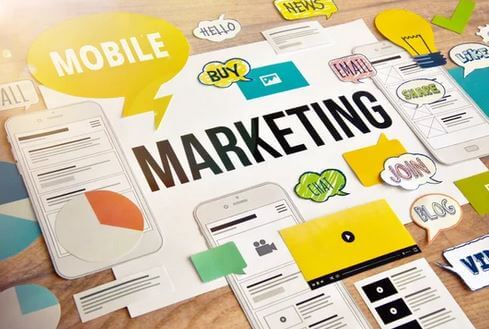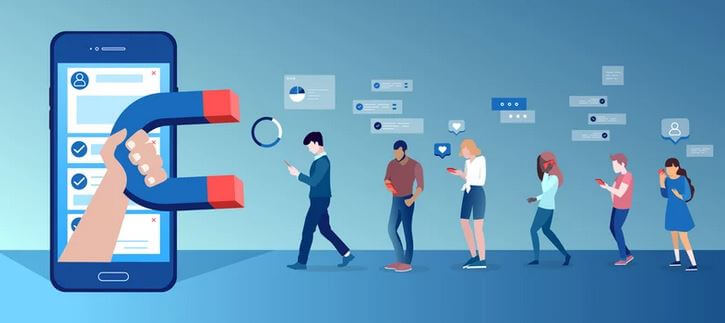Mobile Marketing
Introduction Of Mobile Marketing
Mobile marketing promotes products or services through mobile devices such as smartphones and tablets. With the rapid growth of mobile technology and the increasing amount of time people spend on their devices, mobile marketing has become an essential part of any business’s marketing strategy. This article will explore the various types of mobile marketing strategies, platforms, and best practices for measuring and optimizing campaigns.
What is Mobile Marketing?
- Mobile marketing is the use of mobile devices to promote products or services.
- It includes SMS and M.M.S. marketing, in-app marketing, mobile advertising, and location-based marketing.
- Mobile marketing allows businesses to target their audience in real-time, wherever they are.
Importance of Mobile Marketing
- Mobile devices have become an integral part of people’s lives, with more than 5 billion people worldwide using smartphones.
- People spend an average of 3 hours per day on their mobile devices.
- Mobile marketing allows businesses to reach their audience in real-time, increasing the chances of conversion.
- It also allows for personalization and tailored messaging, leading to a better customer experience.
With the growing importance of mobile marketing, businesses must have a solid strategy to take advantage of this powerful marketing channel. The following sections explore mobile marketing strategies, platforms, and best practices for measuring and optimizing campaigns.
Mobile Marketing Strategies
Mobile marketing promotes products or services through mobile devices such as smartphones and tablets. In this section, we will explore the various types of mobile marketing strategies that businesses can use to reach their audience.
SMS Marketing
- SMS (Short Message Service) marketing uses text messages to promote products or services.
- SMS marketing allows businesses to reach their audience directly on their mobile devices.
- It is a cost-effective and immediate way to reach customers, with open rates as high as 98%.
- SMS marketing is best used for time-sensitive promotions, reminders and alerts, and opt-in campaigns.
M.M.S. Marketing
- M.M.S. (Multimedia Messaging Service) marketing uses multimedia messages (images and videos) to promote products or services.
- M.M.S. marketing allows businesses to add a visual element to their messaging and increase engagement.
- It is best used for product demos, event invitations, and personalized messages.
In-App Marketing
- In-app marketing is the use of mobile apps to promote products or services.
- It allows businesses to target their audience using a specific app, increasing the chances of conversion.
- In-app marketing can be ads, push notifications, and in-app purchases.
Mobile Advertising
- Mobile advertising is the use of mobile devices to display ads.
- It allows businesses to reach their audience through various channels, such as social media, search engines, and mobile apps.
- Mobile advertising can be banner ads, interstitial ads, and native ads.
Location-Based Marketing
- Location-based marketing uses a mobile device’s G.P.S. to deliver personalized and relevant user messages based on location.
- It allows businesses to target their audience in real-time, wherever they are.
- Location-based marketing can push notifications, SMS messages, and mobile ads.
Each mobile marketing strategy has its strengths and limitations. Businesses should consider their audience, goals, and budget when choosing the right campaign design. The following section will explore the various mobile marketing platforms businesses can use to implement these strategies.
Mobile Marketing Platforms
Mobile marketing promotes products or services through mobile devices such as smartphones and tablets. This section will explore the various mobile marketing platforms businesses can use to implement their strategies.
SMS Platforms
- SMS platforms are software that allows businesses to send and receive SMS messages.
- These platforms provide features such as contact management, scheduling, and analytics.
- Examples of SMS platforms include Twilio, Nexmo, and Plivo.
Mobile App Platforms
- Mobile app platforms are software that allows businesses to create and manage mobile apps.
- These platforms provide features such as user management, push notifications, and in-app purchases.
- Examples of mobile app platforms include Appcelerator, Xamarin, and PhoneGap.
Mobile Advertising Platforms
- Mobile advertising platforms are software that allows businesses to create, manage, and track mobile ads.
- These platforms provide features such as targeting, budget management, and analytics.
- Examples of mobile advertising platforms include Google AdMob, Facebook Ads, and Apple iAd.
Location-Based Platforms
- Location-based platforms are software that allows businesses to create and manage location-based campaigns.
- These platforms provide features such as real-time targeting, tracking, and analytics.
- Examples of location-based platforms include Foursquare, PlaceIQ, and InMarket.
Choosing the right mobile marketing platform depends on the business’s goals, audience, and budget. Companies can choose a single platform offering a wide range of features or combining different media to create a more comprehensive mobile marketing solution. The following section will explore the best practices for measuring and optimizing mobile marketing campaigns.
Measuring and Optimizing Mobile Marketing Campaigns
Mobile marketing promotes products or services through mobile devices such as smartphones and tablets. This section will explore the best practices for measuring and optimizing mobile marketing campaigns.
Key Performance Indicators (KPIs)
- Key Performance Indicators (KPIs) are metrics used to measure the effectiveness of a mobile marketing campaign.
- KPIs include open rates, click-through rates, conversion rates, and return on investment (R.O.I.).
- By monitoring these KPIs, businesses can identify which aspects of their campaign work well and which need improvement.
A/B Testing
- A/B testing compares the performance of two different versions of a mobile marketing campaign.
- This allows businesses to identify which version of the campaign performs better and adjust accordingly.
- Examples of elements that can be tested include subject lines, ad copy, and call-to-action (C.T.A.) buttons.
Personalization
- Personalization is tailoring mobile marketing messages to a specific audience’s needs and preferences.
- Personalization can increase engagement and conversions.
- Personalization can be achieved through data such as browsing history and purchase history.
Optimizing for Mobile
- Optimizing for mobile is ensuring that mobile marketing campaigns are designed and executed optimally for mobile devices.
- This includes ensuring that campaigns are mobile-friendly, have a clear and concise message, and are easy to interact with on a small screen.
- Optimizing for mobile can improve campaign performance and user experience.
Measuring and optimizing mobile marketing campaigns is an ongoing process that requires businesses to continuously monitor and adjust their campaigns based on the performance data. By following these best practices, companies can ensure their movements are as effective as possible. The following section will explore the best practices for mobile marketing campaigns.
Mobile Marketing Best Practices
Mobile marketing promotes products or services through mobile devices such as smartphones and tablets. This section will explore the best practices for mobile marketing campaigns.
Mobile-Friendly Design
- Mobile-friendly design is the process of designing mobile marketing campaigns that are optimized for mobile devices.
- This includes ensuring that campaigns are easily readable and navigable on a small screen, using a responsive design, and using large, clear fonts.
- Mobile-friendly design can improve user experience and increase conversions.
Short, Concrete Messages
- Mobile users are likelier to read and act on short and concrete messages.
- Avoid using jargon or overly complex language in mobile marketing campaigns.
- Instead, use simple, direct language that conveys your message quickly and effectively.
Opt-In and Permission-Based Marketing
- Opt-in and permission-based marketing is obtaining consent from users before sending them mobile marketing messages.
- This can improve the chances of users interacting with your campaigns and lead to a better user experience.
- It also helps to stay compliant with regulations such as TCPA and GDPR.
Integration with Other Marketing Channels
- Integrating mobile marketing campaigns with other marketing channels can increase their effectiveness.
- For example, a mobile marketing campaign can be integrated with an email, social media, or offline campaign.
- Integrating mobile marketing with other channels can increase brand awareness and increase conversions.
By following these best practices, businesses can ensure their mobile marketing campaigns are as effective as possible. A well-executed mobile marketing campaign can help companies to reach their audience in real-time, increase conversions, and improve customer engagement. Businesses must stay updated with the latest mobile marketing trends and adjust their strategy accordingly.
Conclusion
Mobile marketing promotes products or services through mobile devices such as smartphones and tablets. This article has explored the various types of mobile marketing strategies, platforms, and best practices for measuring and optimizing campaigns.
Recap of Mobile Marketing
- Mobile marketing is the use of mobile devices to promote products or services.
- It includes SMS and M.M.S. marketing, in-app marketing, mobile advertising, and location-based marketing.
- Mobile marketing allows businesses to target their audience in real-time, wherever they are.
Future of Mobile Marketing
- Mobile technology is constantly evolving, and the future of mobile marketing is expected to include new technologies such as 5G, artificial intelligence, and virtual and augmented reality.
- Businesses must stay informed of these developments and adapt their mobile marketing strategies accordingly.
- The use of mobile devices is expected to continue to grow, making mobile marketing an increasingly important part of any business’s marketing strategy.
Additional Resources
- Many resources are available to help businesses learn about mobile marketing, including blogs, forums, and industry publications.
- Businesses can also find mobile marketing services and consulting firms to help them develop and execute effective mobile marketing campaigns.
Mobile marketing is an essential component of any business’s marketing strategy. Companies can develop effective mobile marketing campaigns that reach their audience in real-time and drive conversions by understanding the various systems, platforms, and best practices. Companies must stay informed of the latest developments as technology evolves and adapt their strategies accordingly.
F.A.Q.
What Are Some Free Mobile Marketing Tools?
Several free mobile marketing tools can help businesses reach and engage with their mobile audience. Some popular free mobile marketing tools include:
- WhatsApp Business: A free messaging app that allows businesses to communicate with customers in real-time, send automated messages, and create customer support chatbots.
- Instagram for Business: Allows businesses to create a free account, post and schedule stories, track metrics, and run ads.
- Hootsuite Insights: A free social media monitoring and analytics tool that allows businesses to track mentions, hashtags, and competitors on various social networks, including Instagram, Facebook, and Twitter.
- Canva: A free graphic design tool that allows businesses to create visually appealing graphics and videos for social media, mobile ads, and more.
- Google Analytics: A free web analytics service that allows businesses to track website traffic, user behavior, and conversions on mobile and desktop.
- Short Message Service (SMS) Marketing: A free way to send text messages to customers, it allows businesses to send time-sensitive information and alerts, special promotions, and reminders.
- Q.R. Codes: A free way to create Q.R. codes that customers can scan using their mobile devices to access special promotions, discounts, or other information.
- In-app messaging: Free features allow businesses to send messages to their app users, such as push notifications, in-app messaging, or in-app notifications.
These are just a few examples of free mobile marketing tools available; it’s essential to research and compare different options to find the one that best meets the needs of your business. Remember that some of these tools may require a paid plan for specific features and a higher volume of usage.
Why is mobile marketing important?
Mobile marketing is essential because it allows businesses to reach and engage with customers on their mobile devices, which are increasingly becoming the primary way people access the internet and consume media.
- Mobile usage is increasing: The use of mobile devices is proliferating, with more people using their smartphones and tablets to access the internet, check social media, make purchases, and consume media. Businesses risk missing out on a large and growing target audience segment by neglecting mobile marketing.
- Personalization: Mobile marketing allows for more personalized and targeted messaging, as businesses can use customer behavior and demographics data to create tailored campaigns. This can lead to more effective marketing and higher conversion rates.
- Location-based marketing: Mobile devices are equipped with G.P.S. technology, allowing businesses to target customers based on location. This can be used for location-based promotions, targeted ads, and personalized offers.
- Cost-effective: Many mobile marketing tools are free or low-cost, making them accessible for small and medium-sized businesses.
- Real-time engagement: Mobile marketing allows businesses to reach customers in real time with SMS, push notifications, and in-app messaging. This can send time-sensitive information, special promotions, and alerts.
- Cross-channel integration: Mobile marketing can be integrated with other channels, such as email marketing, social media, and web analytics, to create a cohesive customer journey.
Mobile marketing is essential because it allows businesses to reach and engage with customers who spend most of their time on mobile devices. By neglecting mobile marketing, companies risk missing out on a large and growing target audience segment.






